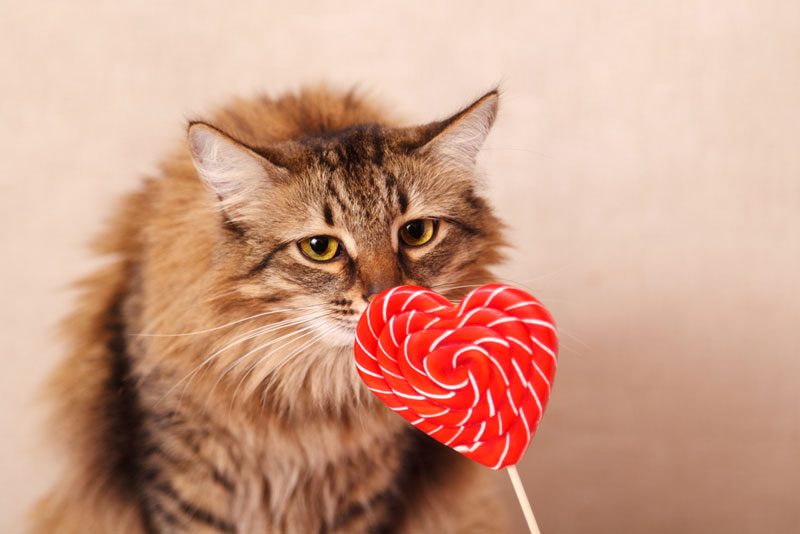Have you ever wondered if your fluffy feline friend could enjoy a sweet treat like candy? The answer is no, cats cannot eat candy. While it might seem like a fun idea to share your sweets with them, candy can be harmful and should definitely be off-limits for our little furry companions.
It’s important to keep in mind that cats are obligate carnivores, meaning their bodies are designed to digest meat rather than sugary treats. Candy contains ingredients that can upset your cat’s stomach or even lead to more serious health issues. But don’t worry, there’s still a world of tasty treats that are safe for them to enjoy!
So, let’s explore the reasons why candy isn’t safe for cats, what other options we have, and what you should do if your cat sneaks a piece. Stick around, because we have some sweet alternatives that will have your cat purring with delight!
Can Cats Eat Candy?

When it comes to sharing snacks with our pets, we often want to include them in our culinary adventures. Cats, with their big eyes and adorable meows, might make it hard to resist sharing a piece of candy. However, it’s vital to understand that candy simply isn’t part of a cat’s diet. Unlike humans, felines do not need sugar for energy; in fact, too much sugar can lead to obesity and dental problems. Candy often contains ingredients that are harmful to cats, such as chocolate, xylitol, and certain artificial sweeteners. These components can cause harmful reactions in our cats, and the last thing we want is to hurt our furry friends.
In humans, sugary foods can lead to feelings of pleasure and happiness. Just think of how we crave candy for that quick boost! However, our pets don’t share the same affinity for sugar. Their taste buds and system are wired differently. Candy can create digestive disturbances leading to vomiting or diarrhea in cats. Keeping all this in mind helps us keep our cats healthier while still being a loved member of the family. Sharing our food isn’t always the best option when it comes to them!
How Much Candy Can Cats Eat?
Since we’ve established that candy isn’t suitable for cats, you might still be curious about those “just-in-case” scenarios. What if your cat manages to get a hold of some candy? It’s vital to understand not only that candy shouldn’t be part of a cat’s diet, but how critical it is to monitor their consumption of any human food. While some human foods can occasionally be safe in moderation, candy is not one of them. If your cat has eaten candy, you need to think about the type of candy they managed to consume. Chocolates and candies containing xylitol are especially dangerous, while some candies may just cause mild stomach upset.
If, by some chance, your kitty digs into a stash of sweets, you’ll have to act quickly. The first thing to do is check the ingredients. If xylitol or chocolate is involved, be sure to contact your veterinarian immediately. Even small amounts of these substances can lead to very serious health problems. For example, xylitol can cause a rapid drop in blood sugar, leading to symptoms such as lethargy, seizures, or even liver failure. Likewise, chocolate can be highly toxic, depending on the type consumed and the size of your cat.
For those optimistic that their cat won’t get into any mischief, it’s still best to keep candy jarred tightly away from those sneaky paws. Instead, providing your cat with small amounts of cat-safe treats in controlled portions will create a happier environment for both of you. Regularly sticking to our furry friends’ unique nutritional needs is the most important part of making sure they live a happy and healthy life.
As tempting as it might be to offer your cat a piece of candy during celebrations or as a one-off treat, always resist that urge! Keep in mind that a cat’s delicate stomach and system are much better suited for snacks that are specifically formulated for their health. If it’s not cat food or a vet-recommended treat, it’s best to leave it out of reach.
Benefits Of Candy To Cats
1. Healthy Alternatives: Instead of reaching for the candy jar, we can explore healthier options! From crunchy kibble to squishy wet food, there are tons of flavors and textures specifically designed for cats. These are crafted to deliver the right balance of nutrients, improving their overall well-being and making them happier. A healthy diet is key to keeping our kitties happy and thriving.
2. Bonding Time: Sharing treats can also create a strong bond between us and our feline friends. Introducing safe treats meant for cats can make them feel loved and appreciated, especially when given with some gentle pets and praise. It turns snack time into playtime, adding to the companionship that is pivotal to a pet-owner relationship. After all, who doesn’t enjoy a little bonding with a furry companion in the midst of snack time!
3. Controlled Diet: Snacking is exciting, but being mindful of what our cats eat is equally important. By giving them cat-centric treats, we put ourselves in control of their caloric intake. Unlike candy, these alternatives are usually lower in sugar and higher in proteins and vitamins. This helps ensure they maintain a healthy weight while enjoying their tasty rewards.
4. Nutrients: Many cat treats are fortified with additional vitamins and minerals that help support a cat’s health. For example, treats may contain omega fatty acids that contribute to a shiny coat or taurine which can be essential for heart health. Selecting the right treats can make a significant improvement in our furry friends’ lives and ensure they get all the good stuff they need.
5. Enriched Social Living: Fostering healthy habits allows for a better lifestyle and enriches our lives and our cat’s lives. Enjoying snack time together creates positive associations with meals and can help reduce anxiety or stress. This also allows us to monitor their eating habits and ensures they’re not getting into anything they shouldn’t be, such as candy.
Dangers Of Feeding Candy To Cats
As cute as it can be to witness our beloved pets getting all excited over candy wrappers, we must keep in mind the potential risks involved with allowing them to consume these human snacks. One of the significant dangers is the risk of sugar toxicity, which could lead to obesity and an array of other health issues over time. Cats aren’t designed to process sugar efficiently, so indulging them in sweets can mean starting a problem that may be difficult to manage in the long run.
Another risk stems from specific ingredients commonly found in candy. Chocolate is one of the most well-known dangers, particularly dark chocolate. It contains theobromine and caffeine, which cats’ bodies cannot metabolize. Almost all cats who ingest chocolate can experience symptoms like vomiting, diarrhea, rapid heart rate, and even seizures. If you suspect your cat has ingested chocolate, seek veterinary assistance immediately.
Xylitol, a sugar substitute, is also extremely toxic to cats. This substance is often found in sugar-free candies and gum. It can cause a rapid decline in blood sugar levels and lead to liver failure. Symptoms such as staggering, weakness, and seizures should prompt immediate contact with a vet. While it is uncommon for cats to eat candies containing xylitol, its presence in certain products can easily lead to risky situations.
Even products that seem harmless can have lasting complications. Gummy candies can pose a choking hazard, while hard candies can harm teeth or gut health if consumed. Incidents of digestive distress from even tiny amounts of candy aren’t uncommon. If your cat suddenly appears lethargic, vomiting, or showing any signs of discomfort after a candy binge, it is crucial to reach out to your veterinarian.
Substitute Of Candy For Cats
1. Catnip: One of the most beloved alternatives is catnip! This magical herb can bring out playful behaviors and happiness in many cats. Catnip has been found to have calming effects and often has cats purring in joy. It can be given in various forms, such as dried leaves or sprays, either as a treat or sprinkled over toys.
2. Commercial Cat Treats: Pet shops are filled with options created explicitly for kitties! These treats come in various flavors like chicken, fish, or beef. When selecting commercial treats, look for ones high in protein and low in fillers. They often even contain additional nutrients, giving a double whammy of anticipation and health!
3. Freeze-Dried Treats: Ever considered using freeze-dried meats or fish? They are a fabulous option! These treats retain nutrients locked in during the freeze-drying process. A sprinkle of chicken or tuna can turn heads, and most cats find them irresistible!
4. Cooked Chicken or Turkey: Who says home-cooked isn’t better? Cooked lean meats such as chicken or turkey can be a delicious and safe choice. Portions should be small and unseasoned, allowing those taste buds to go wild without slathering in spices. This not only satisfies any cravings but also keeps them healthy!
5. Veggies and Fruits: Believe it or not, some cats enjoy small bits of certain fruits or vegetables! For example, small portions of peas, carrots, or melon can be palatable for some felines. Always check old vet recommendations before introducing new foods; not all fruits and vegetables are suitable or safe for cats.
Can Cats Eat Candy? Frequently Asked Questions
What Should I Do If My Cat Eats Candy?
If your cat gets into some candy, it is essential to check the ingredients. Seek veterinary help immediately if it contains harmful substances like chocolate or xylitol.
Are There Any Sugar-free Candies That Are Safe For Cats?
It is best to avoid sugar-free candies entirely, as most contain xylitol, which is very toxic. Stick to cat-specific treats instead!
Can Cats Eat Chocolate-flavored Treats?
Chocolate is highly toxic for cats, so avoid any chocolate-flavored treats or foods.
What Are Safe Snacks For Cats?
Some safe options include commercial cat treats, small amounts of cooked meats, and occasional fruits or veggies.
Can I Give My Cat Sweet Fruits Like Bananas?
Some cats might enjoy a small piece of banana, but not all cats will be interested in fruit. Always introduce new foods slowly and in small amounts.
Final Thoughts
Although it can be tempting to share our treats with our cats, candy is a definite no-go! We love our furry companions too much to let them consume anything that could harm them. Thankfully, there are tons of other fun alternatives that they’ll enjoy just as much.
Remember, the best way to care for our pets is to keep them healthy and happy. Whether it’s seeking vet-approved treats or using moments to bond through interactive play, there’s always a better route than candy. If you’re interested, we can read more about what else is safe for our furry friends by exploring more topics like cat nutrition and care or checking out what to do if your cat eats pineapples. Let’s keep our pets and our cuddly pals safe, happy, and whisker-licking good!


